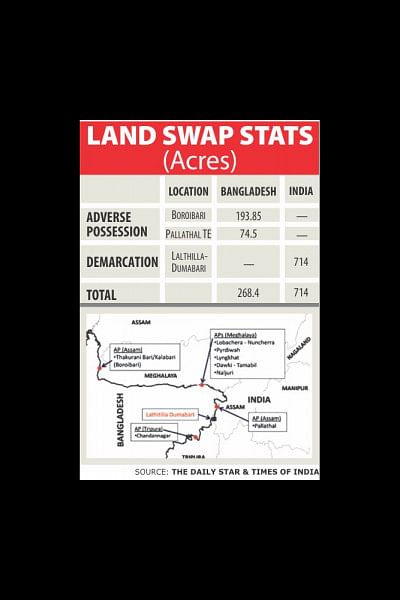A truncated deal is unacceptable

THE long-awaited Land Boundary Agreement (Constitutional Amendment) Bill is going to be tabled in the upper house of the Indian Parliament on May 5, 2015. But it is disappointing that Assam has been 'kept out for now' from the purview of the Bill. Even the Assam government is completely in dark about this sudden turn around. This one-sided move by the Indian central government contravenes the Land Boundary Agreement (LBA) 1974 and the Land Boundary Protocol (LBP) 2011. Both the agreements stipulate Assam as an integral part of the Bangladesh-India border problem. There is no scope for partial fulfillment of the border treaties. After waiting for a long 41 years a truncated land boundary deal will only reinforce the anti-Indian politics in Bangladesh. It will have a dampening effect on the growing relations between the two neighbours.
BORDER ISSUES AT THE ASSAM AREA
Assam shares a 262 km land boundary with Bangladesh. A stretch of around 2.5 km length of the border at the Lathitilla/Dumabari area of Assam had been disputed by both the countries. The LBP 2011 resolved the issue along the 'line drawn by Radcliff' and by taking into account the 'actual position on the ground'. Under this arrangement Assam will get 714 acres of land.
The issue of adverse possession has also been resolved by the 2011 Protocol. Bangladesh will get around 268.40 acres of the total adverse possessed land between Bangladesh and Assam. The Protocol concludes that the interests of tea and paan planters situated in this disputed area have been protected while finalising the border between India and Bangladesh in this sector.
Recently, Chief Minister of Assam Tarun Gogoi in a letter to PM Modi wrote: "It is seen as a result of the re-demarcation, approximately 714 acres of land area in Lathitilla area will formally become part of India (Assam) and an area of 193.85 acres of land in Boroibari and 74.55 acres of land in Pallathal area will formally belong to Bangladesh. Therefore, India (Assam) will formally get a net land area of 445.6 acres with reference to the Radcliff Line."
Meticulous joint surveys on the ground by both the parties have established that the stipulated share of Bangladesh (268.4 acres) has been in de facto possession of the country since even before its creation.
In respect to these ground realities, a document of India External Affairs Ministry titled ' India & Bangladesh : Land Boundary Agreement' notes that "in reality the transferred area has already been in possession of Bangladesh and the handing over of these areas to Bangladesh is merely a procedural formal acceptance of a de facto reality on the ground. The same applies to Indian Adverse Possessions within Bangladesh that would be transferred to the Indian Union in implementation of the 2011 Protocol."
So, according to the LBP 2011 there are no outstanding border issues between Bangladesh and India.
WHAT STANDS IN THE WAY?
A PTI report states that Assam has been kept out of the Bill due to sensitivities in that state. What are they? Who is raking up such opposition against the LBA?
The All Assam Students Union (AASU), Assam Gono Parishad (AGP), BJP and their affiliated organisations have been opposing the LBA in Assam for a long time. In Congress-led UPA's tenure, though the LBP 2011 was signed, the agreement could not be ratified because of massive protests by these organisations. During the 2014 Lok Sabha campaign, Modi had announced at every rally in Assam that not an inch of the state's land would go to Bangladesh. It was one of the main election agendas flaunted by BJP in Assam. BJP gained seven out of 14 Lok Sabha seats in that poll. Now the Assam Assembly poll is due early next year and Assam BJP aspires to come to power. They do not want to face a backlash in the poll going against their own chauvinistic anti-Bangladeshi propaganda.
Since1985, infiltration by Bangladeshis has been a key issue in Assam's politics. According to the Assam Accord, signed in 1985, immigrants from Bangladesh are not allowed to be deported from Assam. So, there is a fear among Assamese people of being marginalised to a minority by Bangladeshi infiltrators. BJP along with AGP and AASU have been playing on this latent anti-Bangladesh sentiment held by a large section of Assamese people. By creating an emotive opposition to the imagined land transfer to Bangladesh they are only trying to reinforce their support base.
Due to such politicisation of the land boundary issue, a large section of Assamese people believe that all the land claimed by Bangladesh actually belongs to Assam. Hence ceding 268.4 acres of it to Bangladesh is absolutely unacceptable to them. But they fail to admit that Assam is getting the lion's share of the disputed land and the ceded area is already in possession of Bangladesh; handing over the land to Bangladesh is merely a formal acceptance of a de facto reality on the ground.
WHY INCLUSION OF ASSAM IS SO IMPORTANT
The lack of clarity on the boundary between Bangladesh and India often causes tensions between the two countries and takes toll on the lives of the people living in these areas. The deadliest fight between the border forces took place in Boroibari (Assam) in 2001. In that firing incident 16 BSF personnel were killed. According to the Assam Chief Minister Gogoi, "The agreement, if ratified along with the clauses relating to Assam sector would not only lead to a permanent solution to the long standing India-Bangladesh border disputes in the Assam sector but also facilitate demarcation of undemarcated areas in Lathitilla-Dumabari." The boundary deal will enable both the countries to curb smuggling, illegal migration, and other criminal activities. But keeping out a part of the border undemarcated will only make it prone to increased criminal activities. It will ultimately thwart the whole border management plan.
The deal will create huge economic opportunities for both Bangladesh and Assam. Assam can be a big export market for Bangladesh. The landlocked Assam can also garner huge economic benefits by getting connected with Bangladesh. A settled boundary can also revive the moribund South Asia Growth Quadrangle (SAGQ), comprising India's north east, Bangladesh, Nepal and Bhutan.
THE WAY FORWARD
After getting elected to office, Indian Prime Minister Modi had said that while the deal may result in short-term losses the country will gain in the long term and Assam's interest will be protected. We urge the Indian PM to hold on to this spirit, assuage the baseless anti-Bangladeshi sentiments in Assam and include Assam in the Land Boundary Agreement Bill.
The writer is Sr. Editorial Assistant, The Daily Star.
E-mail: [email protected]

 For all latest news, follow The Daily Star's Google News channel.
For all latest news, follow The Daily Star's Google News channel. 



Comments